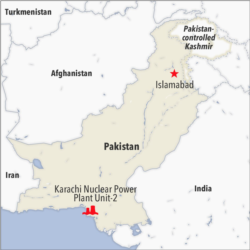Pakistan has connected its new Chinese-built nuclear power plant, with an installed capacity of 1,100 megawatts, to the national grid.
The development marks a major new advancement in nuclear energy cooperation between Islamabad and Beijing.
A spokesman for the Pakistan Atomic Energy Commission (PAEC), Shahid Riaz Khan, confirmed that the newly built plant in the southern port city of Karachi went into operation late Thursday, generating much-needed “reliable and cost-effective” electricity.
The facility, known as the Karachi Nuclear Power Plant Unit-2 (K-2), will help improve the national economy, said a PAEC statement.
“The coming online of K-2 will nearly double the generation capacity of nuclear power plants in the country, substantially improving the overall share of nuclear power in the energy mix,” said an official announcement. It will surely help improve the economy of the country.
Until now, the collective generation capacity of all Pakistan’s five nuclear plants was roughly 1,350 megawatts, five percent of the national electricity generation. Four of the plants, also built with Chinese assistance, are located in Chashma in Mianwali district.
Canada helped Pakistan build its first nuclear power plant in 1972 in Karachi, which is currently producing around 80 megawatts of electricity, according to officials. The facility has almost lived its life and is expected to be abandoned once K-2 and K-3 are fully operational.
China is constructing another similar nuclear plant next to K2, named K-3, with an installed capacity of 1,100 megawatts. Officials said the second unit “is expected to be operational by the end of 2021.”
The construction of the Chinese-supplied third generation Hualong One reactors began in 2015 and 2016 respectively, at a combined estimated cost of roughly $10 billion. The reactors are equipped with “advanced safety and foolproof security features.”
Khan explained the nuclear power plants come with “double containment” to help contain radio activity in case of an accident or subversive acts.
“In the event of a terrorist attack to sabotage the facility from outside, it will not be able to directly hit the plant and damage,” Khan said. “The container dome is designed in such a way that only its external wall would be damaged in case a big passenger plane like Boeing crashed into it.”
The site where K-2 and K-3 are being built is more than 12 meters above sea level, giving them protection against tsunamis.
Both the power plants will have an operational life of 60 years. Under the agreement, China will provide fuel for them, just like it has a been doing for the four plants operating in Chashma, Khan said.
He said that all of Pakistan’s civilian nuclear facilities, including K-2 and under-construction K-3, are under International Atomic Energy Agency (IAEA) safeguards.
Islamabad intends to generate around 8,800 megawatts of nuclear power by 2030 and 40,000 megawatts by the year 2050.
Chinese investment has also constructed at least nine coal-based power plants over the past six years in Pakistan and more are in the pipeline, helping the South Asian nation effectively overcome years of energy crisis.
The multibillion-dollar collaboration, known as the China-Pakistan Economic Corridor (CPEC), an extension of Beijing’s global Belt and Road Initiative, has upgraded and built new road networks and expanded the Pakistani deep-water Arabian Sea port of Gwadar.





